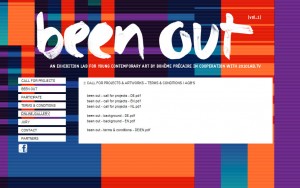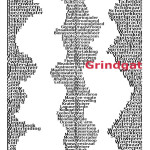Guess who I met? Travelled to The Hague for business reasons, had some time to…
Been out – be in?
Just pressed the ‘send’ button for my Hide Me, Hide You proposal for Been Out Vol.1 – the Dortmund call for papers that landed on my desk a couple of weeks ago.
The Been Out people have a great website. On it, they discuss what is happening to the cities in the Ruhrgebied: on the one hand there is de-industrialisation, which created a vacuum in the way public space is used; on the other hand the Internet plus the advance of mobile platforms creates new options and possibilities for the use of public space.
In their own words: “public space undergoes an enormous expansion by new technologies in the virtual reality of the internet and the physical world. Privacy becomes permeable. Data protectionists are considered petty nitpickers and spoil-alls when it comes to the global game with identities. Digital networks such as the social web, with their promise of participation in worldwide communication, are alluring stages for those who want to be a producer in a culture of participation. The side effects are exhibitionism, voyeurism and a commercial exploitation which has seemingly already been existing before a new idea makes the stage. Yet, the new media are no longer some toy for the nerds, but have long become a natural part of daily routine, social communication, work – and they have become part of art production, art presentation, and art mediation, too. They promote a global culture of democratic exchange of information which provides people from developing or threshold countries who have access to the world wide web with new opportunities to organise themselves – thus, they are feared by dictatorial regimes. Computer viruses and worms are new tools in the armoury of global conflicting interests. But instead of completely retreating into virtual worlds like the one suggested in computer games like World of War Craft, public, urban space experiences a renaissance in the sense of a place of encounter, of social and political discourse. Instead of perfecting the kind of cyberspace which 80s science fiction dreamed of, digital network media connect the physical space via smartphone or netbook with the ephemeral community of the ever-present Facebook friends – towards a hybrid environment with a lot of hot spots and interfaces. A youth frustrated by the incapability of the old elites to battle the current economy crisis effectively uses the social web and smartphone apps to give their protest a collective voice. The locations of their manifestations are historical plazas in capitals like Madrid or Athens. In some countries of the Arabian world, even governments could be overthrown by using Facebook and Twitter. These young people (when coming from one of the crisis-ridden European countries, sometimes every other one of them is unemployed) use the new media to demand their right to work and a better future and to appropriate public space. According to art theoretician Nicoloas Bourriaud, a flexible person of our days has one crucial question: what is my next station? He is looking for a direction to develop and optimise himself, while he is permanently busy with being himself (Alain Ehrenberg), and running after the promise of the countless things he could be, current cultural practices and contemporary artistic strategies often answer this question by returning to public, urban space, to the community. When the residents of the global village can only react passively to the consequences of international complexities of economic, political, or social kind, they long for an intersubjectively shared culture according to the definition by Habermas. They long for places of physical encounter, exchange, discourse. Street art, flashmobs, interventions, guerilla gardening, parcour, boomboombox parties or adbusting – those are the new practices of contemporary popular culture. The challenges faced by modern man are reflected by the strategies of a contemporary art committed to participation and based on aesthetics of correlating people to others, such as the installations by Rirkrit Tiravanija, the happenings by Christoph Schlingensief, or urban screen projects inviting you to participate, for example. mission . The exhibition laboratory been out invites you to participate in the call for projects by diverse submissions. The submissions should be focused on the artistic interpretation of the following assumptions: Metropolises which were once at least respected due to their economic power such as the cities of the Ruhr are subject to a continuous transformation process. The movement of the heavy industry towards other countries left vacant spaces at many places which, according to a long-term political agenda, should be filled with a strengthening of the following sectors: science, education, service, culture, and creative industry. These vacancies in the cityscape of the Ruhr are often marked by dysfunctional urban surroundings; living and working quarters which had been conceived by the logic of an industrial-based economy are now void of their original purpose. Inner city limits, uniform shopping malls with their omnipresent commercial slogans, and the proliferation of temporary “bargain” shops, and gambling halls are, among other factors, characteristic for urban areas in times of economic crises. 2. Instead of being used for a complete retreat into a virtual present, digital network technologies like social networks expand physical space, becoming tools for a reappropriation of public space as an area for communication, social encounter, and discourse by their users. Conceived by numerous cultural practices and artistic strategies, a hybrid area is generated which combines the possibilities of digital network media with sensual experiences, and at the same time creates new perspectives on urban space and new temporary communities. Parallel to that, shifts and permeabilities regarding the limits of private and public matter will occur in virtual space. Contemporary cultural practices in urban surroundings have the potential to disengage the participating citizens temporarily from their role of being an isolated, passive, and observing consumer of information, merchandise, and services, and to invite them to an examination of their own physicalness, the possibilities of public space, and to dialogues with others. The objective of these participatorial projects is to break up the logic of urban space -which has been generated and marked by everyday routine and predictable, economic rules- by means of creative and not result-oriented artistic interventions. The participants, first being mere, isolated observers in urban space, become emancipated, creative, or reflective individuals, being aware of themselves as part of a citizen community. They represent the opposite model to the passive consumer of omnipresent commercial contents who accepts the surveillance of his movements in public space. 3. questions: note : What kind of contemporary artistic strategies can examine these shifts in physical and/or virtual public space? How does art reflect these cultural phenomena, how does it work with them, how does it treat them, how does it react? How can these artistic strategies help to transform dysfunctional urban spaces into places of communication, community, and discourse again? What does the art of the „Digital Natives“ look like?
| « Hide Me Hide You | <-- previous post | next post --> | Labyrinth [4] » |
|---|








